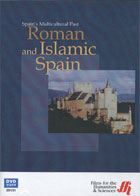
Spain's Multicultural Past
Episode 1: Roman and Islamic Spain
Episode 2: The Spanish Reconquista 2005
Distributed by Films Media Group, PO Box 2053, Princeton, New Jersey 08543-2053; 800-257-5126
Producer n/a
Director n/a
DVD, color, 53 min.
Jr. High - Adult
Architecture, Art History, European Studies, History, Travel and Tourism
Date Entered: 02/28/2006
Reviewed by Linda Frederiksen, Washington State University, Vancouver, WAEstablished in 1972, World Heritage sites are those designated by UNESCO to be of universal historical, cultural or natural value. The list of sites currently includes over 800 places around the globe that are protected for future generations. From its earliest history, the Iberian Peninsula has been a crossroad for Africa and Europe and the fusion of this heritage is reflected in the unique cultural artifacts of the country, a number of which are now preserved as World Heritage sites. In this two-part series, several of these sites serve as a backdrop for a brief history of the area.
Spain's early Roman and Islamic past are the focus of the first episode. Three World Heritage sites - the gold mines of Las Medulas, the amphitheatre of Merida and the aqueduct of Segovia - provide viewers with a look at pre-Christian architecture in the region. The influence of eight centuries of Islamic rule is reflected in the Moorish vernacular architecture of Granada, and the residential district of Albaycin. The episode concludes with a visit to the city of Toledo, where Romans, Visigoths, and Muslims successively resided.
The return of Christian rule to the region is the subject of the second episode. Beginning in the 9th century, a western influence returned to the Iberian Peninsula and, with it, centuries of warfare to reclaim the land from Moorish rule. Early pilgrims followed a path from the French border to Santiago de Compostela, which is now preserved as a World Heritage site. The history of the region during the middle ages is seen as viewers visit a Gothic cathedral at the fortified city of Avila. A stopover at the Alhambra Palace marks the end of Islamic rule, and a return to the Toledo cathedral shows Spain at the height of its power as the age of exploration begins.
This beautifully photographed, edited and narrated educational film provides an interesting view of the natural and cultural treasures of the region. Part history lesson and part travelogue, the series presents numerous facts and figures about the various sites while at the same time introducing significant historical movements. The dramatic mixture of eastern and western influences over a long historical period is a fascinating one for those studying or visiting the Iberian Peninsula.